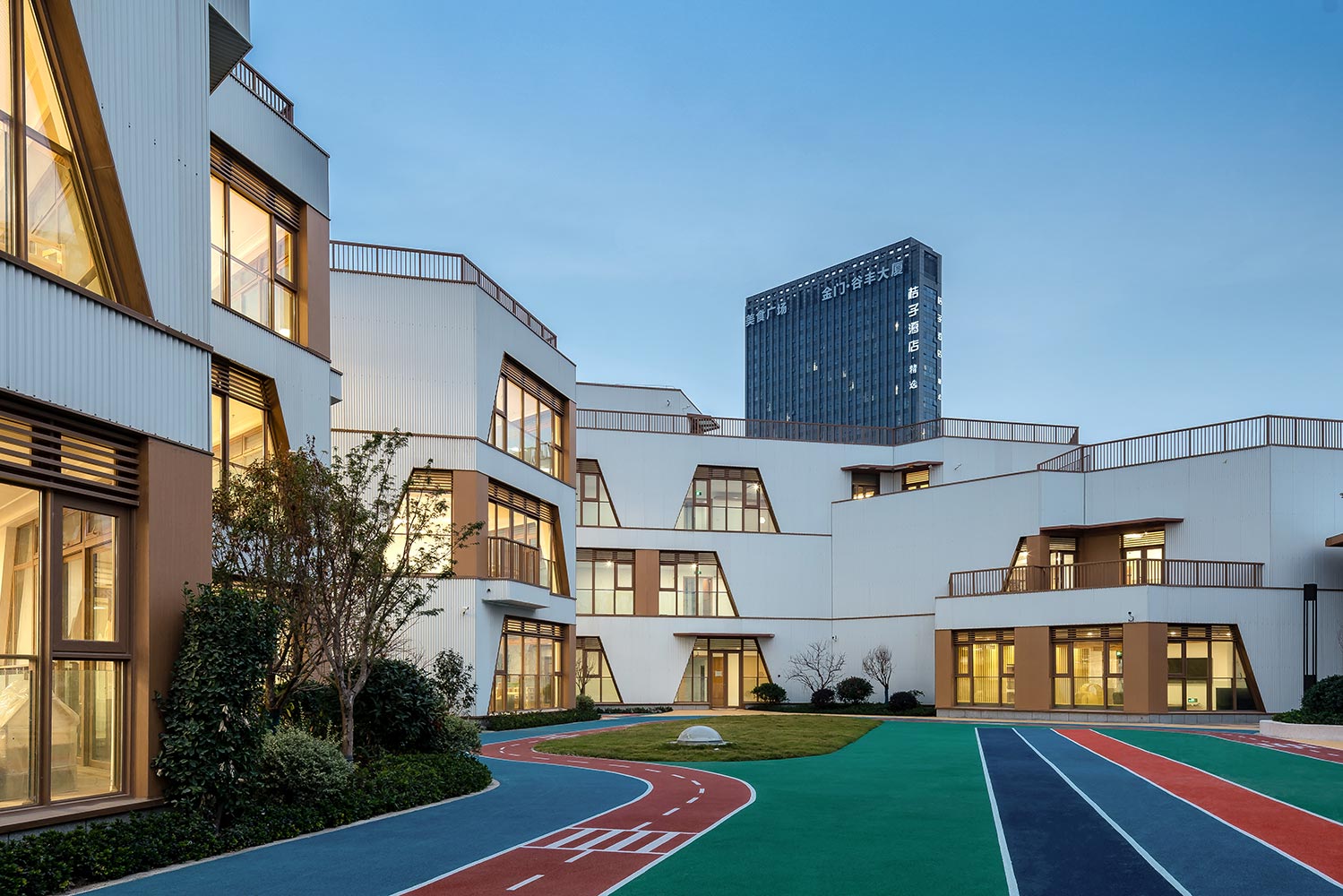杭州浦乐幼儿园杨家墩分园 位于杭州市滨江区,总建筑面积约7800㎡。滨江区作为一个拥有包括阿里巴巴等众多高新科技产业的地区,其实力在杭州各区的排名中日益增强,近年来对于教育设施也有着更高的要求。在此情况下,建筑师试图在有限的工期与造价条件下,以模块化构思结合快速建造方式来完成一座“吸引人”的幼儿建筑。
杭州浦乐幼儿园 对“六边形”母题的运用,将场地限制的不利条件转化为设计亮点。用地周围高层建筑环绕,日照条件并不乐观;菱形的用地形状与正南方向存在60°的夹角,如利用传统的正交网格布局,采光朝向、日照时间和用地效率无法同时达到理想状态。基于此,“六边形”母题成为一种解题思路——这种形状是自然界最常见的形态,具有“完全充填”和“最具效率”的双重优势。六边形类蜂巢的组合顺应场地的斜角,能够最大程度获取采光,兼顾良好朝向、日照时数与场地的贴合率等多项需求。
六边形母题带来很多非直角空间,这些空间正符合幼儿乐于探索和嬉戏的天性。为进一步打破单调的走廊模式,一条曲曲折折的“活动带”作为骨架应运而生,联系着各个空间单元。另一方面,为保证幼儿在局促场地中的户外活动,建筑师试图从三维上进行空间的拓展。建筑体量沿着城市道路层层退台,形成一系列不同标高的屋顶露台,开放给学生作为底层活动空间的延伸。
项目的材料选择是基于有限造价的创新。在传统砌体窗墙体系基础上,外饰面层使用白色波纹彩钢板,入口雨棚使用竹钢材料。传递清新而温暖的建筑氛围。由于装配率的要求,地上主体结构采用多层钢结构框架体系,工厂预加工的方式使得湿作业大大减少。最终,建筑师通过巧妙的空间及营造策略,在较为苛刻的条件下仍然实现了一座具有亲和力和吸引力的幼儿建筑。
Hangzhou Pule Kindergarten Yangjiadun Branch, covering a total construction area of approximately 7,800 square meters, is located in Binjiang District of Hangzhou, a region packed with high-tech industries including Alibaba and rising in rankings among districts in Hangzhou. In recent years, the district has set higher demands for educational facilities. In this case, the architects managed to build an "attractive" children’s facility with a modular idea and a rapid construction method under the limited construction period and costs.
The application of "hexagon" motif in Pule Kindergarten has turned the unfavorable conditions of site restrictions into design highlights. Surrounded by high-rise buildings, the sunlight conditions on the site are not that optimistic. There is an angle of 60 ° between the diamond land and the south direction. Given the fact that it is impossible for daylighting orientation, sunshine duration and land efficiency to reach their ideal state at the same time by adopting a traditional orthogonal grid layout, the "hexagon" motif thus becomes a problem-solving idea as hexagon is the most common form in nature and boasts the dual advantages of "complete filling" and "most efficient". The combination of hexagonal beehives conforms to the slope angle of the site to introduce maximum daylight, while taking into account many requirements such as good orientation, sunshine duration and the fit rate of the site.
The "hexagon" motif creates lots of non-right-angled spaces, which are in line with the nature of children to explore and play. In order to further break the monotonous corridor pattern, a zigzag "active space" was marked out as skeleton to connect each space unit. On the other hand, to ensure children's outdoor activities in the cramped field, the architects managed to extend the space in three dimensions. The building retreats along the city road layer by layer, forming a cascade of roof terraces with different elevations, which is open to students as an extension of the activity space on the ground.
The project selects materials based on innovation with limited costs. The exterior finish layer uses white corrugated color steel plate based on traditional masonry window and wall system, and the entrance canopy uses bamboo steel to create a fresh and cozy architectural atmosphere. The main structure on the ground adopts a multi-layer steel frame system to meet the requirement of assembly rate, and the pre-processing method in the factory reduces the wet construction work greatly. Finally, through ingenious space and construction strategies, the architects managed to create a children’s building with affinity and attractiveness under severe conditions.
业主 Client
杭州滨江区教育局 Hangzhou Binjiang District Education Bureau
所在地址 Location
浙江省杭州市 Hangzhou, Zhejiang
建筑规模 GFA
7,800 ㎡ 7,800 ㎡
项目类型 Type
教育 Education
设计范围 Design scope
建筑 Architectural
设计周期 Design period
2017 - 2019




